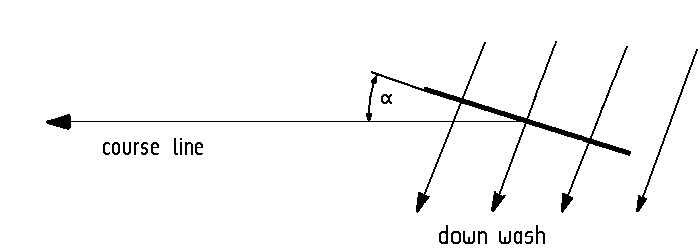Jan Peter Apel
The
Basic Formula of Flying
The physical formula for lift differs in that, that lift does not come
from
an aerodynamic, but from an aerokinetic process. A wing draws air with
its top towards it and presses air with its bottom down, both
according to the principle of the inclined plane. The air sucked in
from above combines behind the wing with the air pushed down from the
bottom into a uniform air flow, the down wash, as the following sketch
shows.

The
recoil force resulting from the acceleration of the air mass is
calculated by Newton's force formula in the version with constant
speed. It gives the force, that the air exerts against the wings.
F
= m dt · v
The
velocity of the down wash is:

vdownwash
= vplane
* sin a
The vertical sink speed of the down wash, that is that speed of the
air, that creates the lift force, is:

vsink
= vplane
* sin a
* cos a
Now must determinate, how much the mass flow per second of
the down wash is. It
results from the density of the air times that area, that the
wings cover in one second times the
vertical downward speed of the down wash. That is:
m
dt = rho
* (vplane
* 1
[s]
* wing span) *
( vplane
* sin a *
cos a)
This
mass of air flows vertically down through the lavel of the flight path.
The reaction force from this mass is then calculated according to
Newton's force formula by multiplying with the speed of the downward
flowing air mass:
Recoil
force = lift force =
density
flight area per second
velocity
of down
wash
velocity
of down
wash
for the
air mass
for the recoil force
rho * (v
plane *
wing span) * (vplane *
sin a *
cos
a) * (vplane * sin
a * cos a)
*
1[s]
Summarized
the lift force
L
is:
L
= rho · wing span
· vplane3
· (sin α)2 ·
(cos α)2 · 1
[s]
This physically formula of flying is based on
the
air mass
accelerated downwards by wings. How technology creates this with
appropriate wing shapes and wing profiles is up to it. The angle of
attack of the wing surfaces is decisive in any case. It alone is the
basis of flying. What is happening in the air in the immediate vicinity
of the wing profiles are only symptoms of what ultimately has to be
done in order to be able to fly: behind all flying objects, especially
the bumblebee too, air mass must flow down, only that has the
corresponding repercussions for the development of the buoyancy force
That the airspeed
is included with the third power is not an error. In free air space,
however, an aircraft cannot achieve this state, since by increasing
the angle of attack the increasing lift deflects the trajectory upward,
so
that the angle of attack drops again. In school, however, at last
flying can be treated.